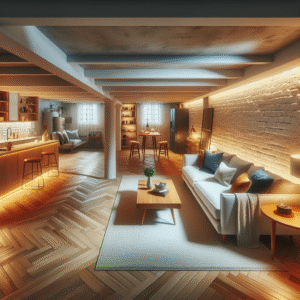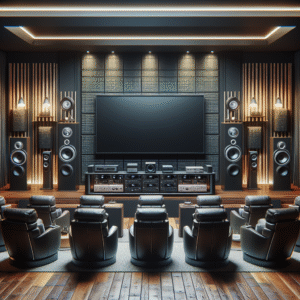In today’s world, where remote work has become more common, having a functional and comfortable home office is essential. A well-designed home office not only boosts productivity but also enhances comfort, allowing you to stay focused and motivated throughout the day. Whether you’re working full-time from home or need a space to tackle side projects and manage household tasks, creating the right environment is key to success.
In this comprehensive guide, we’ll explore how to set up a functional home office that supports productivity and comfort. From selecting the right location to choosing ergonomic furniture and managing distractions, these tips will help you create a workspace that fits your needs and improves your work-from-home experience.
1. Choose the Right Location for Your Home Office
The first step in creating a functional home office is selecting the right location. The ideal space should be quiet, well-lit, and away from distractions. While not everyone has the luxury of a dedicated room for their home office, there are ways to make the most of any space in your home.
Tips for Choosing the Best Location:
- Look for Privacy: Choose a space where you can work without interruptions, especially if you have children, pets, or roommates. If a separate room isn’t available, consider converting a quiet corner of a living room, bedroom, or even a large closet into your office.
- Avoid High-Traffic Areas: Try to avoid setting up your office in areas of the home that see a lot of foot traffic, like the kitchen or hallway. Noise and movement in these areas can make it difficult to concentrate.
- Consider Natural Light: Natural light boosts mood and productivity, so if possible, choose a location near a window. A well-lit workspace can reduce eye strain and improve focus throughout the day.
- Maximize Small Spaces: If space is limited, get creative with your home office setup. A fold-out desk, wall-mounted shelves, or a multi-functional space (e.g., a desk that doubles as a dining table) can make small areas work efficiently.
By selecting a location that offers privacy and minimal distractions, you’ll set the foundation for a productive and comfortable home office environment.
2. Invest in Ergonomic Furniture for Comfort and Health
One of the most important aspects of a functional home office is choosing the right furniture. Since you’ll be spending hours sitting and working, it’s essential to invest in ergonomic furniture that promotes comfort and good posture. Poor ergonomics can lead to discomfort, back pain, and fatigue, all of which can negatively impact your productivity and health.
Key Ergonomic Furniture to Consider:
- Ergonomic Office Chair: A high-quality, adjustable office chair is one of the most important investments for your home office. Look for a chair with lumbar support, adjustable height and armrests, and a comfortable seat cushion. Proper chair height allows your feet to rest flat on the floor, and your knees should be at a 90-degree angle.
- Standing Desk or Adjustable Desk: Standing desks have become increasingly popular as a way to reduce the negative effects of prolonged sitting. An adjustable desk allows you to alternate between sitting and standing throughout the day, improving circulation and reducing the risk of musculoskeletal problems.
- Keyboard and Mouse Positioning: Your keyboard and mouse should be placed at a height that allows your arms to rest comfortably at your sides with your elbows bent at about 90 degrees. Consider using an ergonomic keyboard and mouse to reduce strain on your wrists and hands.
- Footrest: If your feet don’t comfortably touch the floor while sitting, a footrest can help maintain proper posture and reduce strain on your legs.
Investing in ergonomic furniture not only improves comfort but also promotes better physical health, helping you stay focused and pain-free during long work hours.
3. Organize Your Workspace for Efficiency
An organized workspace is essential for productivity. Clutter and disorganization can lead to distractions and wasted time searching for important items. Creating a tidy and efficient home office setup helps you stay focused and on task.
Tips for Organizing Your Workspace:
- Declutter Regularly: Keep your desk free of unnecessary items. A cluttered workspace can overwhelm your senses and make it difficult to concentrate. Use drawers, shelves, or storage boxes to keep items out of sight and reduce visual clutter.
- Use Desk Organizers: Invest in desk organizers, such as trays, bins, or drawer dividers, to store office supplies like pens, notepads, and paperclips. Keeping your tools within reach and neatly arranged saves time and reduces frustration.
- Create Vertical Storage: If your desk space is limited, make use of vertical storage solutions. Wall-mounted shelves, pegboards, or hanging file organizers can help you keep documents and supplies organized without taking up valuable floor space.
- Label and File Documents: Set up a filing system for important papers and documents. Use labeled folders, trays, or binders to keep your paperwork organized and easy to find. Consider going paperless by scanning documents and storing them digitally for easy access.
By keeping your workspace organized, you’ll create a more productive environment where everything you need is easily accessible.
4. Set Up Proper Lighting for Focus and Comfort
Lighting plays a significant role in creating a comfortable and productive home office. Poor lighting can lead to eye strain, headaches, and fatigue, while well-placed lighting can enhance focus and create a pleasant atmosphere.
Types of Lighting to Consider:
- Natural Light: If possible, position your desk near a window to take advantage of natural light. Natural light boosts mood and energy levels, making it easier to stay focused. However, be mindful of glare on your computer screen, which can cause discomfort.
- Task Lighting: Task lighting, such as a desk lamp, provides focused light for specific activities like reading, writing, or typing. Choose a lamp with adjustable brightness and positioning to reduce shadows and glare.
- Ambient Lighting: In addition to task lighting, ambient lighting fills the room with soft, even illumination. Overhead lights, floor lamps, or wall sconces can provide ambient light to prevent eye strain and create a warm, inviting atmosphere.
- Avoid Harsh Lighting: Fluorescent lights or overly bright lighting can be harsh on the eyes and cause discomfort. Opt for warm, natural light bulbs or adjustable LED lights that allow you to control the brightness.
Creating a well-lit home office ensures that you can work comfortably and maintain focus throughout the day without straining your eyes.
5. Minimize Distractions and Noise
Distractions are one of the biggest challenges of working from home, especially if you share your living space with others. Managing noise and minimizing distractions will help you maintain concentration and stay on task.
Strategies to Reduce Distractions:
- Set Boundaries with Family or Roommates: Let your family or roommates know your work schedule and ask for their cooperation in minimizing noise during work hours. Setting clear boundaries helps reduce interruptions and allows you to focus on your tasks.
- Use Noise-Cancelling Headphones: If you’re working in a noisy environment, noise-cancelling headphones can block out background sounds and help you concentrate. Listening to calming music or white noise can also improve focus.
- Create a ‘Do Not Disturb’ System: Consider using a visual cue, such as a closed door or a “Do Not Disturb” sign, to signal when you’re in the middle of a task and should not be interrupted.
- Take Regular Breaks: While it’s important to minimize distractions during work hours, taking regular breaks is essential for maintaining productivity. Use the Pomodoro Technique (working for 25 minutes, then taking a 5-minute break) to stay focused while allowing yourself short intervals to rest and reset.
By reducing noise and distractions, you’ll be able to create a more focused and productive work environment, allowing you to accomplish more in less time.
6. Personalize Your Space for Inspiration and Comfort
Your home office should not only be functional but also a space that inspires and motivates you. Personalizing your office with décor and design elements that reflect your personality and work style can boost creativity and make the space feel more inviting.
Ways to Personalize Your Home Office:
- Add Artwork or Inspiring Quotes: Hang artwork or motivational quotes that inspire you to stay focused and positive throughout the workday. Choose pieces that align with your style and create a sense of calm or motivation.
- Bring in Plants: Adding plants to your workspace can improve air quality and create a more relaxing atmosphere. Studies have shown that indoor plants can reduce stress, boost mood, and enhance productivity.
- Use Comfortable and Stylish Décor: Choose décor that makes you feel comfortable and reflects your personal style. This could include cozy rugs, throw pillows, or a comfortable chair for reading or brainstorming.
- Create a Vision Board: A vision board can serve as a visual reminder of your goals and aspirations. Pin photos, quotes, or sketches that represent your professional and personal objectives, and keep it within view to stay motivated.
Personalizing your space makes it more enjoyable to work in, which can increase your overall satisfaction and productivity.
7. Ensure Adequate Technology and Connectivity
No home office is complete without the right technology to support your work. Having reliable equipment and a fast internet connection is essential for efficiency and communication. Make sure your workspace is equipped with the tools you need to perform your tasks seamlessly.
Essential Technology for Your Home Office:
- High-Speed Internet: A fast and stable internet connection is crucial for remote work, especially if you’re attending video meetings, downloading large files, or using cloud-based software. Invest in a reliable internet service to avoid connectivity issues.
- Computer and Monitor Setup: Depending on your work, you may need a desktop computer, laptop, or both. If you spend long hours on the computer, consider using an external monitor to reduce eye strain and improve posture.
- Printer and Scanner: If your work involves handling physical documents, having a printer and scanner on hand is essential. All-in-one printers that also function as scanners can save space and provide the tools you need for efficient document management.
- Backup and Data Security: Protect your work by using cloud storage services like Google Drive, Dropbox, or OneDrive. Regularly back up important files and documents to prevent data loss. Additionally, consider using antivirus software and password protection to safeguard your digital information.
Having the right technology ensures that you can perform your work efficiently and stay connected with colleagues, clients, or team members.
8. Create a Work-Life Balance in Your Home Office
One of the challenges of working from home is maintaining a healthy work-life balance. It’s easy to blur the lines between work and personal life when your office is just a few steps away. To avoid burnout and maintain a healthy balance, it’s important to set clear boundaries and establish routines.
Tips for Creating a Work-Life Balance:
- Set a Work Schedule: Establish a set schedule for work hours, and stick to it as much as possible. Avoid the temptation to work outside of your designated hours, and use this time to relax or spend time with family.
- Create a Daily Routine: A consistent routine helps signal to your brain when it’s time to work and when it’s time to relax. Start your day with a morning routine that includes getting dressed, eating breakfast, and mentally preparing for the day ahead.
- Take Breaks and Move Around: Incorporate regular breaks into your workday to stretch, walk around, or grab a snack. Moving around helps reduce stiffness and fatigue, keeping your mind and body refreshed.
- Disconnect After Work: Once your workday is over, shut down your computer and step away from your home office. Creating a physical and mental separation between work and leisure time helps you unwind and recharge for the next day.
Establishing clear boundaries between work and personal life will help you maintain productivity while also ensuring that you have time to relax and recharge.
FAQ
1. What’s the most important factor in creating a functional home office?
The most important factor is ensuring that your home office is both comfortable and efficient. Ergonomic furniture, proper lighting, and an organized workspace are key components of a functional home office that promotes productivity.
2. How can I reduce distractions when working from home?
To reduce distractions, set boundaries with family members or roommates, use noise-cancelling headphones, and create a dedicated workspace where you can focus. Establish a routine that minimizes interruptions during your work hours.
3. Do I need a separate room for my home office?
While a separate room is ideal, it’s not always necessary. You can create a functional home office in a quiet corner of your home using space-saving furniture and thoughtful design choices.
4. How can I make my home office more comfortable?
Invest in ergonomic furniture, such as an adjustable office chair and desk, to ensure comfort during long work hours. Adding personal touches, like plants and artwork, can also create a more inviting and comfortable workspace.
5. What technology do I need for a home office?
Essential technology for a home office includes a reliable computer, high-speed internet, and any specific tools or software required for your work. You may also need a printer, scanner, and backup solutions to protect your data.
Conclusion
Creating a functional home office is essential for productivity, comfort, and maintaining a healthy work-life balance. By choosing the right location, investing in ergonomic furniture, organizing your space, and personalizing your environment, you can design a workspace that supports your professional goals. Whether you’re working remotely full-time or need a space for occasional projects, the tips in this guide will help you create a home office that enhances both your productivity and well-being.








